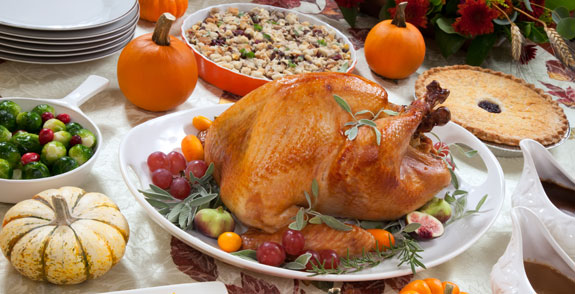Author: Ross Hsu
Thanksgiving is complicated. In its modern form, the holiday is almost entirely secular, and pretty indistinguishable from other harvest festivals around the world, aside from the distinctly American food and football. Thanksgiving is also a historical account, and an amalgam of different holidays and traditions, and, on the whole, is a myth. But it’s a good myth.
Many people I’ve discussed Thanksgiving with use the word myth in a disparaging way, to point out the parts of the Thanksgiving story that are lies. I don’t think of those elements as mythical. I think of them as lies. I use the word myth in the positive sense, in that the mythical parts of Thanksgiving are essential depictions of what we value as a culture, and show a peaceful and grateful character that is as comforting as it is ahistorical.
This is the general gist of the Thanksgiving story: at some point in the early years of the English pilgrim settlement of Plymouth, Massachusetts, probably in 1621, a harvest feast was shared between the pilgrims and about 100 members of the neighboring Wampanoag tribe, the two groups exchanging gifts and food. The food was all native to the New World, and most of what the Europeans prepared was learned from the Wampanoag. The feast lasted about three days.
Based on the few European and Wampanoag accounts we have, this is all sort of true. But these elements, the ones held in the collective American conscience, all have caveats.
The Wampanoag didn’t help the pilgrims in a collective cooperative effort. The groups had a shaky relationship at best. There are several accounts of settlers stealing tools and digging up graves for supplies. In fact, the English-speaking Tisquantum, known popularly as Squanto, did most of the teaching himself. He had been sold as a slave to England and Spain previously, and when he returned to America his tribe had been exterminated. In different accounts, Massasoit, a Wampanoag chief, either led his men to the settlement in fear and response to the pilgrims’ celebratory gunshots, or the pilgrims invited Massasoit to the feast to celebrate a treaty he had signed which effectively made it a capital offense to attack a European, and gave the settlers license to expand on Wampanoag land. Whatever the exact situation, relations between the settlers and the native tribes quickly deteriorated in the following decades. New England set the stage for centuries of oppression and genocide with massacres, wars, subterfuge, trickery and the breaking of promises.
Knowing all of this, it’s perfectly reasonable for Native and European Americans alike to ignore Thanksgiving, or to instead celebrate it as a day of mourning. But Thanksgiving comes from more than just that barely truthful story, and now encompasses what’s great about the modern American myth, which has always been an optimism forged out of altered history and bent truths.
The first official Thanksgiving wasn’t celebrated until 1637, and it was more for show than anything else. Government officials issuing religious proclamations thanking God for victories or good harvests became something of an American tradition and continued into the 19th century. George Washington and other presidents have made thanksgiving proclamations, but the tradition became a national holiday when Abraham Lincoln decreed in 1863 that the last Thursday of every November be a day of “Thanksgiving and Praise to our beneficent Father who dwelleth in the Heavens.” Like most choices Lincoln made during the Civil War, his establishment of the holiday was about national morale and unity. It was only after the holiday became accepted that the apocryphal composite story of the first Thanksgiving became associated with the holiday, so in a way, Thanksgiving has much less to do with that story than it does with religious gratitude and American optimism.
Thanksgiving isn’t about celebrating genocide or European dominance, and in its best form can even be a grim acknowledgment that everything we have as a country comes from pain and sacrifice. That’s not a bad thing, and shouldn’t be ignored. There’s a righteous logic to protesting the holiday or making it a day of mourning, but I can’t understand ignoring or eradicating it. Traditions don’t go away so easily, and the best way to celebrate Thanksgiving is to be educated about the nuance of history, so we can truly honor and respect the tragedy and bloodshed that made America.
Thanksgiving is the result of the best and worst parts of America. Different cultures, racism, the origins of both the land and the nation, the horror of war and the recent attempts to heal old wounds—everything we love and regret about our country is present in Thanksgiving, our oldest and proudest American holiday. Ignoring the truth about its history is wrong, and the day is only improved by acknowledging that we come from a painful past. Knowing that reminds us that even though there’s plenty of work to be done, especially after a year of division and hateful rhetoric in America and around the world, we live in the most generous and accepting period of human history in the most diverse and accepting country in the world. And that’s something worth being thankful for.


